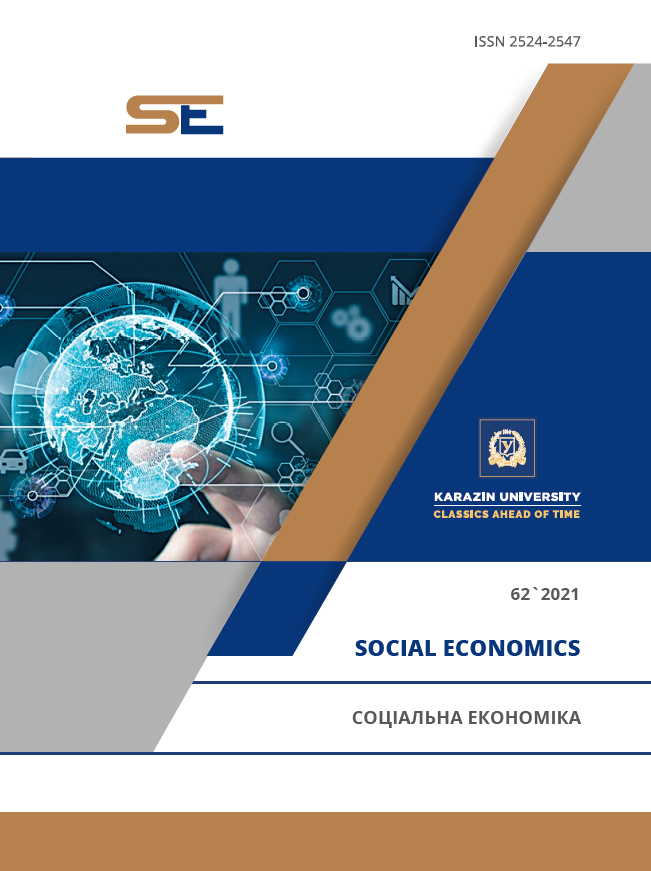THE IMPACT OF THE CORONAVIRUS PANDEMIC ON MACROECONOMIC INDICATORS: ANALYSIS USING A SYSTEM-DYNAMIC APPROACH
Abstract
The article considers theoretical provisions concerning the direct and indirect impact of epidemics / pandemics on the macroeconomic indicators of different countries. The aim of the study is to study how the pandemic affects macroeconomic indicators and the scale of this impact using a system-dynamic concept of simulation to assess long-term trends in the analyzed processes - including combined dynamics and interactions of demographic, epidemic and economic indicators. In particular, we have analyzed and compared supply and demand shocks and economic losses associated with epidemics of different years and study the assumptions of classical compartmental models of epidemics (in particular SARS and SEIR ones) and the experience of system-dynamics concept using in simulating infections spread. The article presents the epidemic and economic situation in Ukraine in 2020-2021. We’ve evaluated the impact of infection spread on demographic indicators and have determined the correlation of the pandemic with the fall of Ukraine’s GDP in percentage to the same period of the previous year, in particular during the first lockdown in March-April 2020. Extension of SEIR model assumptions allowed us to build a demographic-epidemic system-dynamic model, which aggregated results were used in economic model. Both models are implemented in Vensim PLE. The control run results show a high accuracy of real processes reflection. In the economic model the GDP indicator is calculated during the model run, using a dynamized Cobb-Douglus production function, which parameters were estimated on the basis of the real data of Ukraine. The results of the economic model fairly accurately reflect the dynamics of population, capital investment and GDP per capita (the correlation coefficient of model and real data is 0.995). We consider that the main areas of experimentation with the model and of its use in decisions support are forecasting of macroeconomic indicators depending on different scenarios of the Covid-19 pandemic in Ukraine and on measures of its containment.
Downloads
References
Correia, S., Luck, S., & Verner, E. (2020). Pandemics Depress the Economy, Public Health Interventions Do Not: Evidence from the 1918 Flu. Retrieved from https://www.aeaweb.org/conference/2021/ /preliminary/paper/b2RZ9HeZ.
Arnold, B. F, Ercumen, A., Benjamin-Chung, J., & Colford, J. M. Jr. (2016). Brief Report: Negative Controls to Detect Selection Bias and Measurement Bias in Epidemiologic Studies. Epidemiology, 27(5), 637-641. DOI: https://doi.org/10.1097/EDE.0000000000000504.
Barro, R.J. Ursua, J. F., & Weng, J. (2020). The Coronavirus and the Great Influenza Pandemic: Lessons from the “Spanish Flu” for the Coronavirus’s Potential Effects on Mortality and Economic Activity. Retrieved from https://www.nber.org/papers/w26866.
Jorda, O., Singh, S. R., & Taylor, S. R. (2020). Longer-Run Economic Consequences of Pandemics. NBER Working paper series. 48 p.
Kolot, A., & Gerasimenko, O. (2020). Labor in the context of the global socio-economic reality of 2020: challenges for Ukraine. Retrieved from http://library.fes.de/pdf-files/bueros/ukraine/16344.pdf. (in Ukrainian)
Pugachova, О. G. (2021). Modelling the Covid-19 epidemics and its social consequences. NaUKMA Research Papers. Sociology, 4, 18-27. DOI: https://doi.org/10.18523/2617-9067.2021.4.18-27. (in Ukrainian)
Ivashenko, D. S., & Kutsenko, O. S. (2021). Review and analysis of methods of modeling the process of developing the epidemiology. Bulletin of the National Technical University "KhPI", 1(5), 16–19. (in Ukrainian)
Epstein, J. M. (2009). Modelling to contain pandemics. Nature, 460, 687. DOI: https://doi.org/10.1038/460687a.
Khodakivska, O., Tulush, L., Pugachov, M., & Krushelnytskyi, M. (2021), Methodological approaches to assessing the impact of quarantine measures related to the spread of covid-19 on the financial component of the agricultural economy. Ekonomika ta derzhava, 9, 45–51. DOI: https://doi.org/10.32702/2306-6806.2021.9.45.
National Infrastructure Simulation & Analysis Centre USA. (2007). Economic Modeling for the Analysis of Pandemic Influenza.
López, L., & Rodó X. (2020). A modified SEIR model to predict the COVID-19 outbreak in Spain and Italy: Simulating control scenarios and multi-scale epidemics. Results in Physics, 21. DOI: https://doi.org/10.1016/j.rinp.2020.103746.
Godio, A., Pace, F., & Vergnano, A. (2020, May). SEIR Modeling of the Italian Epidemic of SARS-CoV-2 Using Computational Swarm Intelligence. International journal of environmental research and public health, 17(10). DOI: https://doi.org/10.3390/ijerph17103535.
Sy, Ch., Bernardo, E., Miguel, A., San Juan, J. L., Mayol, A. Ph., Ching, Ph. M.,…, & Mutuc, J. E. (2020). Policy Development for Pandemic Response Using System Dynamics: a Case Study on COVID-19. Process Integration and Optimization for Sustainability, 4, 497–501.
Sihombingand, L. B., Malczynski, L., Jacobson, J., Soeparto, H. G., & Saptodewo, D. T. (2020). An Analysis of the Spread of COVID-19 and its Effects on Indonesia’s Economy: A Dynamic Simulation Estimation. DOI: https://doi.org/10.2139/ssrn.3597004.
Currie, С.М., Fowler, J. W., Kotiadis, K., Monks, T., Onggo, B. S., Robertson, D. A., & Tako, A. A. (2020). How simulation modelling can help reduce the impact of COVID-19. Journal of Simulation, 14, 83–97.
Safaie, N., Ghazavi, N., Sarabadani, A., & Nasri, S. A. (2021). Analysis of the effects of COVID-19 virus on the Import, export and labour in Iran using system dynamic approach. Retrieved from https://www.semanticscholar.org/.
Eichenbaum, M. S., Rebelo, S., & Trabandt, M. (2020). The Macroeconomics of Epidemics. (2020). NBER Working paper, 26882.
Lewis, M., & Bell, C. (2004). The Economic Implication of Epidemics Old and New. World Economics, 5(4). DOI: https://doi.org/10.2139/ssrn.1112799.
Boissay, F., & Rungcharoenkitkul, P. (2020). Macroeconomic effects of Covid-19: an early review. BIS Bulletin, 7. Retrieved from https://www.bis.org/.
Loseva, А., & Pankratova, L.(2020). Epidemic Modeling: A History of Development. Retrieved from https://polit.ru/article/2020/06/05/modeling-history/. (in Russian)




